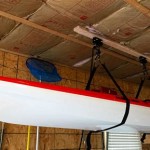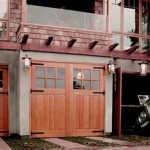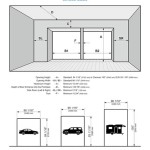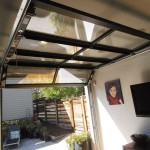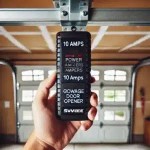Finish Garage Walls: Ideas for Functionality and Aesthetics
The garage, often relegated to mere storage space, possesses unrealized potential for transformation into a functional and aesthetically pleasing area. Finishing the garage walls represents a pivotal step in unlocking this potential. Beyond the cosmetic improvement, finished walls offer enhanced insulation, improved durability, and increased versatility for the space's usage. Selecting the appropriate finishing material and method is crucial to achieving the desired outcome, considering factors such as budget, climate, and intended use.
This article explores various options for finishing garage walls, outlining the benefits and drawbacks of each approach. The goal is to provide a comprehensive guide to empower homeowners to make informed decisions about improving their garage space.
Drywall: A Classic and Versatile Choice
Drywall, also known as gypsum board or sheetrock, remains a prevalent choice for finishing garage walls due to its affordability, ease of installation (with experience), and smooth, paintable surface. Its fire-resistant properties are also a significant advantage, contributing to the overall safety of the home. Drywall consists of a gypsum core sandwiched between layers of paper. The standard thickness for garage walls is typically 1/2 inch, offering a balance between cost effectiveness and structural integrity. For garages that are attached to the house, fire-rated drywall (Type X) is often required by building codes to provide an extra layer of protection against fire spread.
The installation process involves measuring, cutting, and attaching the drywall sheets to the wall studs using screws. Seams and screw indentations are then covered with joint compound (mud) and paper tape. Multiple coats of joint compound are applied, sanded smooth, and primed before painting. While seemingly straightforward, achieving a professional-looking finish with drywall requires skill and patience in the taping and mudding stages. Imperfections in this area will be readily visible after painting. It is possible to hire professionals for drywall installation, which guarantees the smooth finishing and efficient completion.
Drywall is susceptible to moisture damage. Therefore, in garages prone to dampness or humidity, moisture-resistant drywall (also known as "green board" or "blue board," though the color is not always indicative of this type) is a better option. This type of drywall has a water-resistant coating that helps to prevent mold and mildew growth. However, it is not waterproof and should still be protected from direct water exposure. A good vapor barrier behind the drywall will help protect against moisture penetration from the outside.
The primary advantage of drywall is its smooth, paintable surface. This allows for a wide range of aesthetic options and customization. Drywall can be painted with any type of paint, allowing the homeowner to match the garage walls to the rest of the home's interior or to create a unique and personalized space. The smooth surface also makes it easy to clean and maintain.
However, drywall is relatively soft and can be easily damaged by impacts. Dents and holes can occur from tools, equipment, or vehicles bumping against the walls. While repairs are relatively easy to perform, they can be time-consuming and require matching the existing texture and paint. For garages subject to heavy use or potential impacts, consider alternative wall coverings that offer greater durability.
Plywood: A Durable and Functional Alternative
Plywood offers a more durable alternative to drywall for finishing garage walls. Constructed from layers of wood veneer glued together, plywood provides greater resistance to impacts and wear and tear. It is an ideal choice for garages where tools, equipment, or vehicles are frequently moved around or stored. Plywood also provides a robust surface for mounting shelves, cabinets, and other storage solutions.
Plywood is available in various grades and thicknesses. For garage walls, a minimum thickness of 1/2 inch is recommended, with 3/4 inch providing even greater durability. The grade of plywood refers to the quality of the surface veneer. Higher grades have fewer knots and blemishes, resulting in a smoother and more aesthetically pleasing finish. However, higher grades are also more expensive. For garage walls, a mid-grade plywood is often sufficient, balancing cost and appearance.
Installing plywood involves measuring, cutting, and attaching the sheets to the wall studs using nails or screws. Unlike drywall, plywood does not require taping or mudding. However, it is still important to ensure that the seams are properly aligned and secured. Depending on the desired aesthetic, the seams can be left exposed or covered with trim or molding.
Plywood can be painted, stained, or left natural. Painting or staining the plywood provides a protective layer and enhances its appearance. A clear coat of polyurethane can also be applied to protect the wood and provide a durable, easy-to-clean surface. If left natural, plywood offers a rustic and industrial look that is popular in many garages.
One of the primary advantages of plywood is its ability to withstand impacts and heavy use. It is much less likely to dent or puncture than drywall. Plywood also provides a strong and stable surface for mounting shelves, cabinets, and other storage accessories. This is particularly useful in garages where organization and storage are essential.
However, plywood is generally more expensive than drywall. It can also be more difficult to work with, requiring specialized tools for cutting and shaping. Plywood is also susceptible to moisture damage if not properly sealed or protected. In garages prone to dampness or humidity, it is important to use pressure-treated plywood, which is resistant to rot and decay.
Oriented Strand Board (OSB): A Cost-Effective Option
Oriented Strand Board (OSB) is an engineered wood product similar to plywood but made from compressed wood strands glued together. It offers a cost-effective alternative to plywood for finishing garage walls while providing reasonable durability and strength. OSB is often used in construction for sheathing walls and roofs.
OSB is typically less expensive than plywood because it is made from smaller pieces of wood and requires less processing. It is also generally more readily available. For garage walls, a thickness of 1/2 inch or 5/8 inch is recommended, depending on the spacing of the wall studs.
The installation process for OSB is similar to that of plywood. The sheets are measured, cut, and attached to the wall studs using nails or screws. As with plywood, no taping or mudding is required. The seams can be left exposed or covered with trim or molding.
OSB can be painted or stained, but the surface is not as smooth as that of plywood. The wood strands can be visible through the paint or stain, giving the OSB a more textured appearance. Some homeowners find this texture appealing, while others prefer a smoother finish. Using a primer before painting can help to create a more uniform surface.
OSB offers good resistance to impacts and can withstand moderate wear and tear. It is also a relatively strong material, providing a stable surface for mounting shelves and other storage solutions. However, OSB is more susceptible to moisture damage than plywood. It absorbs water more readily and can swell and warp if exposed to moisture for prolonged periods. In garages prone to dampness or humidity, it is essential to use a moisture-resistant sealant or paint to protect the OSB.
One of the main advantages of OSB is its cost-effectiveness. It provides a durable and functional wall covering at a lower price point than plywood. It is also easy to work with, requiring no specialized tools or skills. However, the rougher surface and susceptibility to moisture damage are drawbacks that should be considered.
PVC Panels: A Waterproof and Low-Maintenance Solution
PVC (polyvinyl chloride) panels offer a waterproof and low-maintenance solution for finishing garage walls. These panels are made from plastic and are resistant to moisture, mold, and mildew. They are an ideal choice for garages that are prone to dampness or humidity, or where spills and messes are common.
PVC panels are available in various colors, textures, and sizes. They can be installed directly over existing walls or attached to the wall studs. The panels typically have interlocking edges, making them easy to install and creating a seamless, waterproof barrier. Some PVC panels are designed to mimic the look of traditional wall coverings, such as drywall or wood paneling.
The installation process for PVC panels is relatively simple and straightforward. The panels are cut to size and attached to the wall studs using screws or nails. The interlocking edges snap together, creating a tight seal. No taping, mudding, or painting is required. The panels can be cleaned with soap and water, making them easy to maintain.
One of the primary advantages of PVC panels is their waterproof nature. They are completely resistant to moisture, making them an ideal choice for garages in wet or humid climates. PVC panels are also resistant to mold, mildew, and other types of microbial growth, ensuring a clean and healthy environment.
PVC panels are also very durable and resistant to impacts. They are less likely to dent or puncture than drywall, making them a good choice for garages where tools, equipment, or vehicles are frequently moved around. The panels are also resistant to chemicals and solvents, making them suitable for garages where automotive work or other messy activities are performed.
However, PVC panels are generally more expensive than other wall covering options, such as drywall or plywood. They can also have a more plastic-like appearance, which some homeowners may find less aesthetically appealing. While PVC panels are available in various colors and textures, the selection is not as extensive as with paint or other traditional wall coverings.
In summary, PVC panels offer a waterproof, low-maintenance, and durable solution for finishing garage walls. They are an ideal choice for garages that are prone to moisture or where spills and messes are common. However, the higher cost and less extensive aesthetic options are factors to consider.
Metal Panels: A Robust and Industrial Aesthetic
Metal panels provide a robust and industrial aesthetic for finishing garage walls. These panels are typically made from steel or aluminum and offer exceptional durability and resistance to impacts, fire, and moisture. They are an excellent choice for garages where heavy-duty use and protection are paramount.
Metal panels are available in various gauges, finishes, and profiles. The gauge refers to the thickness of the metal, with lower gauges indicating thicker and more durable panels. The finish can be painted, powder-coated, or left natural, depending on the desired aesthetic. The profile refers to the shape and design of the panel, with options ranging from flat panels to corrugated or ribbed panels.
Installing metal panels typically involves attaching them to the wall studs using screws or rivets. The panels may have interlocking edges or require overlapping for a secure and weatherproof seal. Professional installation is often recommended to ensure proper alignment and attachment.
One of the key advantages of metal panels is their exceptional durability. They can withstand impacts, scratches, and other types of wear and tear without significant damage. Metal panels are also fire-resistant, providing an added layer of protection against fire hazards.
Metal panels are also resistant to moisture, mold, and mildew. They do not absorb water and are easy to clean and maintain. This makes them an ideal choice for garages in wet or humid climates, or where spills and messes are common.
However, metal panels can be more expensive than other wall covering options. They can also be noisy, especially if not properly insulated. The metal can amplify sounds, making the garage less comfortable. Furthermore, metal panels can be susceptible to dents if subjected to significant impacts.
The industrial aesthetic of metal panels may not appeal to all homeowners. However, for those seeking a robust and modern look, metal panels can be an excellent choice. They are commonly used in commercial and industrial settings, as well as in contemporary residential designs.
In conclusion, selecting the appropriate material for finishing garage walls depends on a variety of factors. Considering the specific needs and priorities for the garage space is crucial to making an informed decision that balances functionality, aesthetics, and budget.

Garage Wall Ideas 17 Ways To Improve Your Space

Garage Wall Ideas 17 Ways To Improve Your Space

Creating A Finished Garage On Shoestring Budget

Alternatives To Drywall For Garage Walls Trusscore

How To Finish Your Garage Ideas Designs Salter Spiral Stair

Garage Wall Ideas 17 Ways To Improve Your Space

Interior Garage Paint Ideas 55 Kb Jpeg Walls The Journal Board Http Finished

Creating A Finished Garage On Shoestring Budget

What Are The Best Pvc Garage Wall Panels To Use

The 5 Best Ways To Cover Garage Walls Hunker
Related Posts

